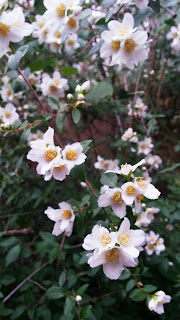 |
| Manzanita in full bloom |
Arctostaphylos sp.-
Manzanita
Dotted with their dangling clusters of shell pink to snowy white bells, Manzanitas situated at lower elevations are stopping shows now in mid-January. While their ubiquity allows us to take these tough-as-nails evergreen shrubs for granted at many times of the year, the sight of their early blossoms as a reminder of spring-yet-to-come is a heart warming sight to many. As much a representative of California's flora as the golden California Poppy, Manzanitas, in all their various shapes and sizes, provide a graceful backdrop for the many later blooming wildflowers. But for now, in the quiet before spring, it is their turn in the limelight. Beautiful.



